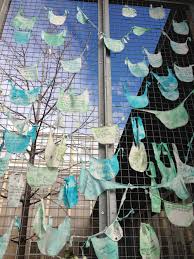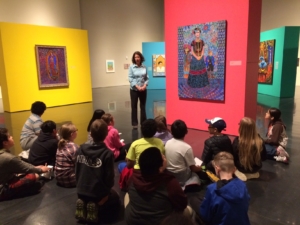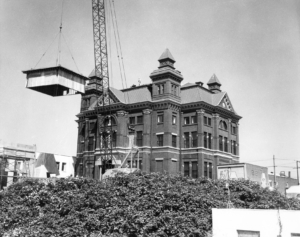Long-time Educator, Mary Jo Maute, Retires After 21 Years
For 21 years, Mary Jo Maute taught the history of the Northwest Coast people to thousands of Whatcom County children, brought art to families experiencing homelessness, inspired high school students, and taught adults painting and art techniques through various workshops. Last month, Maute, an education and program coordinator at the Museum, retired from her position, but her legacy will remain. Before leaving, Maute reflected on her time and experiences at the Museum.
Q&A with Mary Jo Maute
How long have you worked at the Whatcom Museum, and what role(s) have you had?
Twenty one years ago, we moved to Bellingham from Montana, where I had served as the Curator of Education at the Yellowstone Art Museum. We were drawn here for this job at the Museum.
My role has been planning and presenting programs that relate to the permanent and special exhibitions, most often working with school groups to enhance the school curriculum. The school program that has kept me the busiest since day one is the People of the Sea and Cedar tour and workshop. Pretty much every 3rd grader in Whatcom County and many from Skagit, Snohomish, and Island Counties benefit from this program. One would think that running this remarkable program for 21 years would become tiring, but I love working with children and everyone has a good time.
I’ve also coordinated a variety of public programs, including talks by artists, curators, and historians, Family Activity Days (now Community Art Museum Day), Brown Bag lunch programs, Artful Pairings (opportunities for adults to get creative and learn interesting techniques while sipping wine), and concerts, which provide the community with opportunities to engage with our local arts and culture.
“I can say with certainty that Mary Jo is a beloved art teacher, a well-respected colleague and friend of this community!” –Susanna Brooks, Whatcom Museum Director of Learning Innovation
This past spring marked the 20th anniversary of the high school Art Career Day, a special project of mine. Art Career Day builds the next generation of artists, educators, and lifelong creative learners. This conference brings together 130 Whatcom County high school students and their art teachers for a day at the museum meeting with regional artists and college art department representatives.
I’ve also been the education department’s liaison with the museum intern program through Western Washington University’s (WWU) Anthropology Department. It’s been a real joy to give college students a taste of what it’s like to work in a museum and engage with school groups and the public.
What has been one of your favorite programs offered at the Museum?
I like most when I can use the exhibitions as a springboard for a creative collaborative project. A few examples are:
-
Partnering with Pam Kuntz, WWU Dance faculty and artistic director of Kuntz and Company during the Leslie Dill installation in 2012. Together we explored the idea of creating a dance performance in the gallery. There were many fascinating rehearsals as the site-specific dance was choreographed. The result was two sold out, spine-tingling performances with an original score and outstanding cast of student and community dancers.
- Being part of the Vanishing Ice exhibition planning team with our Curator of Art, Barbara Matilsky, and educator, Chris Brewer, as well as numerous community organizations who offered an array of programs on art and science all helping to expand awareness of climate change during the Vanishing Ice exhibition in 2012-13. I invited WWU fiber arts professor Seiko Purdue to come up with a project. The result was a beautiful display of hand-dyed bibs with heart-felt messages that fluttered on the courtyard wall during the exhibition.
- Make.Shift Art Space provided a venue for regional artists to riff off a theme from a few Whatcom Museum exhibits. I thought it would be cool to invite artists to create a unique piece inspired by work from the Museum’s photo archive collection. Jessyca Murphy at Make.Shift agreed and the result was the juried exhibition Making History: Art from the Archive. Many artists enjoyed the challenge and had a great time perusing the photo collection with Jeff Jewell.
How has the education program changed through the years at the Museum?

Hand-dyed bibs with heart-felt messages fluttered on the courtyard wall during the “Vanishing Ice” exhibition in 2013.
The new People of the Sea and Cedar exhibition is an excellent example of how educators and community members can support exhibition planning and design to make the museum experience accessible to all ages, backgrounds, and learning styles. With thanks to Lummi and Nooksack elders, the exhibit includes language interactives and videos showcasing Lummi and Nooksack weavers and carvers, and it presents the tribes as vibrant, living cultures.
Visual literacy and creativity are 21st century skills that have changed through time. Museum educators must engage young people in activities that empower them to respond in their own way to the art and artifacts they find in the galleries.
Could you guesstimate how many Whatcom County school children you’ve interacted with through the years?
More than 100,000 students, parents, and teachers from every corner of Whatcom County and beyond.
What will you miss most about working at the Museum?
I will miss delving into new exhibitions and developing programs for school kids and adults that teach art skills, visual literacy, and instill the pleasure and excitement of learning in a museum setting. It feels good to know you’ve ignited a spark in some young person that might set them on a lifelong journey as an artist, historian, bird-lover, or culture vulture. I’ll miss working as a team with the education, curatorial, marketing, development, and information attendants to plan cool programs and welcome the community into this wonderful, warm, inspiring place of lifelong learning.
“Interning for Mary Jo gave me a chance to gain skills in building avenues for young people to experience art and culture. Mary Jo has a talent for creating opportunities for people to connect with art on a uniquely personal level.” –Lily Dittrich, former Museum intern
Do you have a favorite story about a visitor or student?
Occasionally a teacher will share, “While you were teaching, I observed a child who has shown little interest in school and has rarely raised their hand. During this experience, I see them thrive.” I know the meaning of that experience. That spark was ignited for me when I first visited the Albright Knox Art Gallery and had an AHA! moment looking at Seurat’s Etude pour “Le Chahut,” with its distinct dabs of oil color creating form and emanating light energy. These moments are why I am here today.

Mary Jo Maute (center) with her daughter, Iris Maute-Gibson (left) and retired Museum educator Chris Brewer (right). They are in costume for the Museum’s Victorian Secrets program in 2013. Photo by Roger Dollarhide.
What do you look forward to in retirement?
I look forward to traveling, auditing classes in other subjects of interest, working out at the YMCA, walking the many community trails, and volunteering for community nonprofits. I also look forward to continuing my professional arts career.
Would you like to add any other thoughts or comments?
I feel so fortunate to have found a career that weaves together several of my passions, as art, museums are a place of lifelong learning, and enrich the lives of our youth and community. After 28 years in the museum education field, it is time to pass the torch on to the next generation of educators. I cherish the friends that I have made at the Whatcom Museum including fellow staff, volunteers, interns, teachers, artists, musicians, history buffs, and bird-lovers.










